One path, one destiny
Thanks to Farah Naqib and Noura Kassem for their diligent efforts to start Kuwait Palestine Series and I am grateful for making me the first speaker.
The proposed title is provocative, a teaser to get you interested. I hope it got more audience this way. But it could be the other way round. Why Palestine needs the Gulf? There are many good reasons for that.
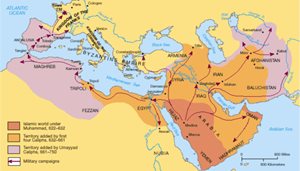 Map-1
Map-1
My preferred title, which is apt and permanent is: we all need each other in the Arab World.
That is the natural thing. Why?
Because for at least 1,400 years we lived in a single Islamic state, much longer than Europe or UK or even USA have ever lived under one government. Map-1 Umayyad.
This government extended from Spain in the West to the borders of China in the East, and on both sides of the Mediterranean. It was a state whose inhabitants were from many races, had many languages, but they have Islam as the dominant faith and Arabic is the language of that faith. Arabic was and is the everyday language of the central core of this state, that is the Arab World. It is only an exception that I speak to you today in English in this foreign language institution.
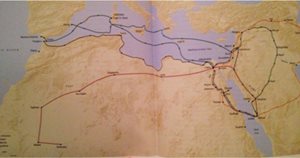 Map-2
Map-2
There was one common history, common geography and common culture. Nothing can illustrate that better than the Hajj routes, Map-2 Hajj Route which have taken pilgrims to Mecca from the heart of Africa, from Andalusia, from the Black Sea, from Sudan, from India, even from China, all travelling within one state, safe and secure, in a harmonious society.
Not only pilgrims, but travelers could roam this vast empire without a visa and without a work permit, living, working, marrying anywhere they please. Take the case of Ibn Jubayr, who travelled in the year 1183, from Al Maghreb to Cairo, Mecca, Damascus, Baghdad and Aleppo; he even witnessed the third Crusade which invaded Palestine, and described its occupation, reminiscent of the Israeli occupation of today.
We have another case: of Ibn Batouta, who 150 years later, in about 1325, travelled from his home town in Tangiers, overlooking the Atlantic Ocean, all the way to China and in between. He also visited non-Muslim countries in Southern Europe and in the heart of Africa. He was called the ‘greatest traveler of all time’, as he surpassed his contemporary traveler, Marco Polo.
This Umayyad state whose capital was Damascus, was superseded by new rulers, the Abbasid, whose capital was Baghdad, after which its weakness led to several local centers of power. Finally, most of this state was reunited under the Ottoman Empire, whose capital was Constantinople. It lasted 400 years, from 1517 to 1917.
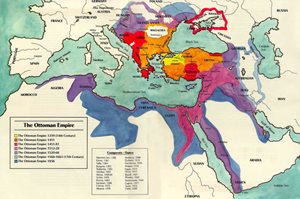 Map-3
Map-3
As the Map-3 Ottoman shows, the strongest rule was in the heavily inhabited areas, in the perimeters of the Arabian Peninsula, on the shores of the Red Sea, the Arabian Sea and the Arabian Gulf. In these areas, there were sheikhdoms whose local rule was the norm with nominal acceptance of the sovereignty of the Sultans’ rule in Constantinople.
The British rule in India spread its influence into the shores of the Arabian Gulf, generally termed in the British literature as the Persian Gulf. Britain arrived at Modus Vivendi agreements with the sheikhs of the Gulf, that they would get British protection from outside threat provided that no foreign power would get a foothold in their territory. Britain’s Political Agent for the Gulf, that the representative of Great Britain, was located in Bushehr on the Iranian side of the Gulf. He reported to the government of the viceroy of India.
Such was the case with Sheikh Khaza’l of Al Muharraqa, who was later deposed and his territory annexed by Persia and renamed Abadan. He was a friend of Sheikh Mubarak of Kuwait. It took almost 70 years for the sheikhdoms of the Gulf to become independent states, members of the United Nations. Kuwait was the first to be independent in 1961, followed by Bahrain, Qatar, which became independent in 1971. The United Arab Emirates had a slightly different history. It was termed by the British as the ‘Pirate Coast’, which was one way of Britain’s interference, and which lead to the Treaty of Truce in 1892, calling these 6 sheikhdoms the Trucial States. This was the case until the United Arab Emirates became independent also in 1971. But the bulk of Arabian Peninsula was unified under King Abdel Aziz Ibn Saud in stages from 1902 to 1932.
The intrusion of Europe into North African countries was much earlier, in the 19th century. Spain, France, and Italy dominated Morocco, Algeria and Libya. In the Arab East, other than the Gulf, the story is somewhat different. Under the pretext of protecting the Khedive of Egypt from the revolt of national Egyptian officers, Britain occupied Egypt in 1882, and remained there until Jamal Abdul Nasser kicked them out 75 years later.
By the beginning of the 20th century, that is about 110 years ago, Europe considered the Ottoman Empire as the ‘sick man of Europe’, and prepared to carve out a juicy piece of the Empire. Europe started sending its spies in preparation of the take-over. The spies were Orientalists, with a strong knowledge of Arabic and a stronger sense of adventure.
The Austrian ‘Hapsburg’ ruling dynasty sent Alois Musill, an accomplished professor of Arabic and Islam. He toured the area and wrote volumes about the tribes of Syria, Iraq, Jordan, Palestine, Hejaz and Najd. He even arrived at an agreement with Amir Sha’alan, Sheikh of Shammar, to establish a state from Damascus to Riyadh under Austrian protection.
Kaiser of Germany sent Baron Max von Oppenheim who visited all the Arab East, east of Suez and had offices in Constantinople, Basra and Jerusalem. He wrote volumes about Arab tribes, their sheikhs, their territory and their military strength.
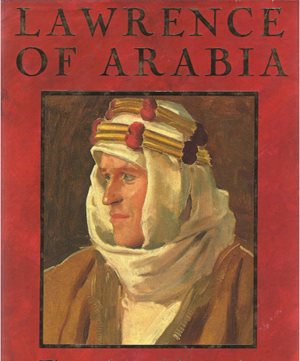 Map-4
Map-4
There were fewer travelers in the hinterland of the Arabian Peninsula because of its remoteness. However, Charles Doughty, toured on a camel and on foot most parts of modern-day Saudi Arabia, and wrote his famous ‘Arabia Deserta’ in quaint, but eloquent English.
Captain Shakespeare started from Kuwait towards Hayel to garner support of the enemy of Ibn Saud, Al Rashid ruler of north Najd. Shakespeare is buried here in Kuwait.
Of all the competing European powers to dominate the area, the British were the winners. Why is that? Because they had a huge base in Egypt since 1882; they severed Egypt from the Ottoman Empire and turned it into a protectorate in 1914. And in this year, World War I started between Britain and Germany and their allies. Turkey became an ally of Germany.
To undermine the Ottoman Empire, Britain encouraged Hussein Ibn Ali, Sharif of Mecca, to lead the Arabs in a revolt against the Turks with the promise that the Arab countries east of Suez, from southern border of Turkey to Yemen, what was called Arab provinces, would be a single independent state under an Arab king.
Here comes Lawrence, the British spy and provocateur. Map-4 Lawrence. He had a hand in helping the Arabs fight the Turks in Transjordan, which they have done successfully. Lawrence became a legend and named Uncrowned King of Arabia. The sad truth he was a side show, as Allenby called him, but his main achievement was cheating the Arabs.
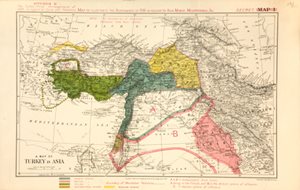 Map-5
Map-5
The worse was yet to come. The British promise of Arab independence was a patent lie. It was a historical betrayal from which we suffer until today. While British and allied planes dropped leaflets on the Arabs proclaiming undying support for their freedom and independence, the colonial powers were scheming secretly to divide the Arab territory between them.
In 1916, the British Sir Mark Sykes, and the French François Georges Picot, sat in a room, with a map on the table and two knives to divide the Arab countries between them. Map-5 Sykes Picot. Palestine, Jordan and Iraq would go to Britain. Syria and Lebanon would go to France, Italy was given a slice of Turkey and Russia had a smaller one. That was, of course, a secret. Who let the cat out of the bag? It was Russia, the Bolshevik revolution, which toppled the Kaiser of Russia in October 1917 and released the document, to the great embarrassment of the British and French allies.
Betrayals never cease. The Sykes-Picot map shows Palestine partly as an international zone, in anticipation of the Zionist colonization of Palestine. Palestine’s location was a dominant factor in the control of the region. Map-6 Location. It is the bridge between Arab Asia and Arab Africa. It connects the Mediterranean with the Red Sea. It protects the vital, historical, military and commercial road between the twin wings of Cairo and Damascus. It is the gate for the defense of Egypt from the East, the direction from which almost all armies attacking Egypt came.
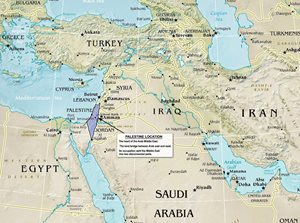 Map-6
Map-6
Early in the year of 1917, there were secret negotiations between rich Jewish Europeans and the British government, to create a colony for the Jews in Palestine, which splits the Arab world into two and becomes the military garrison for the colonial West inside the Middle East. Yet again, this agreement between the foreign minister of Britain, Lord Balfour, and the Zionist leader, Haim Weizman, was kept secret, tucked away in Balfour’s office.
In the same year of 1917, the British army, from its base in Egypt, proceeded to occupy Palestine under the curious name ‘Egyptian Expeditionary Force’. This force failed twice to take Gaza and suffered heavy losses, and its commanding general was fired. General Allenby came in his place and took the advice of his Australian generals to make a surprising detour to attack Beersheba from the east unexpectedly.
At their first success, Beersheba fell in British hands at 6pm on Wednesday, 31st October, 1917. The next morning, on November 1st, Allenby sent a telegram to London: “We have taken Beersheba. Jerusalem will be your Christmas present”. On November 2nd, Balfour opened his drawer, picked up the secret agreement and made his infamous declaration to facilitate the immigration of European Jews to Palestine.
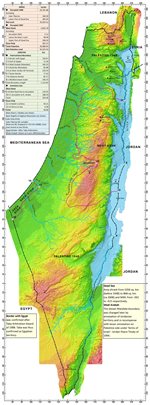 Map-7
Map-7
It was a false promissory note by someone who did not own Palestine and had barely entered it, to an undeserving party, which had no title to the territory, nor set foot on it, in the absence of the Arab majority of the country, who had no knowledge of that promise and indeed no consent to it. Thus began a century of death, destruction and destitution of the people in Palestine, which hardly spared any country in the region.
This is the Palestine which Allenby came to conquer. Map-7 Green. He walked on foot in the streets of Jerusalem as a ruler for the first time after 800 years of the Crusades.
(Map-8: Description of Nakba)
This is the largest comprehensive, planned and continuous ethnic cleansing in modern history. It created the only colonial project in existence today. It also represents the longest occupation in modern history. Every event in the Middle East has been shaped by this calamity ever since. Immediately after 1948, the monarchy in Egypt was toppled and Abdul Nasser rose to power. The King of Jordan, Abdullah the first, was assassinated. Syria had several coup d’états. The Iraqi monarchy was removed. Wars have started almost every 7 years since then. And we are still living in the shadow of this crime.
Now turning to Kuwait, the freedom of moment, under one state, not only enabled pilgrims to travel to Mecca for al Hajj, but to ply their trades in commerce also. Ugail Arabs from Kuwait, took camels for sale to Cairo, Jerusalem and Damascus, and returned with other goods. Religious leaders in Kuwait studied in Al Azhar. Donations were regularly given by Kuwaiti merchants to religious institutions.
It is remarkable to note that Kuwaitis were always aware of and against the Western intrusion in Palestine. Denouncing the Balfour Declaration was echoed in the early Kuwaiti newsletters. In 1929, fanatic Zionists tried to attack the Al Aqsa mosque, and install their equipment at the Burak Wall. They were repulsed in what was known as Al Burak revolt. An international commission investigated the case in 1930 and found that Burak Wall or ‘Western Wall’ of Al Haram aL Sharif, was/is an Islamic waqf for hundreds of years, according to historical documents.
Sheikh Ahmad Al Jaber Emir of Kuwait invited Haj Amin Al Husseini, the Grand Mufti of Jerusalem, in 1932, to come to Kuwait to garner support for Jerusalem. In resonse, the Mufti sent to Kuwait an educational mission in 1936, comprising teachers who remained and their offspring in Kuwait till today.
In the 1940’s, young Kuwaiti students, studying in Iraq, visited Palestine after the 1936-39 revolt against Jewish immigration to Palestine. One of them, as he told me himself, was Jassim Al Saqer, brother of the noted Hamad Al Saqer, and the father of Mohammad Al Saqer.
Such was the temperament of the Kuwaitis about Palestine when Al Nakba struck in 1948, and the Palestinians started to come to Kuwait in large numbers.
Why did they come?
One, that was continuation of the educational mission in Kuwait, most of the early arrivals were teachers. Two, Kuwait was developing faster than anywhere in the Gulf because of oil exports, which started in 1946, so it needed engineers and doctors. Palestinians were readily available for that job. Three, the British influence; those who worked for British Mandate Government in Palestine police and immigration were good candidates approved by the British to continue their work in Kuwait. Four, some businessmen already had commercial relations with Kuwait and they found the opportunity to continue them.
Naturally, after 2 or 3 years of work, the young Palestinian professionals in Kuwait decided to have a family. In the summer holiday, they would return to Kuwait with their brides. Thus was born the first Palestinian generation on the soil of Kuwait.
The test of the common Arab peoples’ aspirations came very soon,after Al Nakba, in 1956. In October of that year, the Tripartite Aggression against Egypt took place. The colonial powers of Britain, France and Israel attacked the Suez Canal in Egypt in retaliation for Nasser’s nationalization of the Suez Canal. There were very strong demonstrations in Kuwait by Kuwaitis and Palestinians. The Kuwaiti support for Arab rights, reinforced by the seasoned Palestinian experience of Al Nakba, was a volatile combination, which the British political agent in Kuwait found very disturbing.
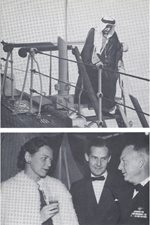 Map-9
Map-9
Map-9 Bell. Here he is in the middle of the lower picture; his name is Sir Gawain Bell. He is standing next to his wife and the American naval commander of the Gulf. He wrote about his concern about oil supply and the influence of Palestinian presence in his book “Shadows on the Sand” and he told me the same when we met in London in 1991. The British policy was therefore against the admission of more Palestinians into Kuwait.
That was not the policy of Sheikh Abdullah Al Salem Al Sabah, the founder of modern Kuwait. Here he is in 1956, in the top picture. He was determined to develop Kuwait with the oil revenue into a modern state with the help of Arabs, mainly Palestinians. In their heyday of the 1980’s, Palestinians had the highest percentage of university graduates, 47 graduates among 1000 population, while the US had only 30/1000 and Russia had 18/1000. Much of the credit goes to Jamal Nasser who in the 1950’s admitted all Palestinians to Egyptian universities free of charge.
Palestinians gained positions in Kuwait, not only in professions, but also in politics and the military. About a dozen Palestinians were granted Kuwaiti citizenship and became ambassadors for Kuwait and generals in the army and police. A noted advocate of Palestine cause in the US, Dr Fayez Sayigh, was attached to the Kuwait delegation at the UN. The head of the delegation was Sheikh Sabah Al Ahmad Al Sabah, the present Emir of Kuwait.
 Map-10
Map-10
With the oil revenue, Kuwait progressed in leaps and bounds. Map-10 Pearl. In 1950, Kuwait was an egg-shaped small town surrounded by the Gulf waters from the north, and the ‘sour’ or the fence on the south on the desert side in the same location as Sour Street today. The inhabitants’ occupations were fisheries, pearls and marine commerce with the Gulf, Aden, East Africa and India.
 Map-11
Map-11
The new development came very fast. Map-11 Traffic. With the first new buildings on Fahd Al Salem Street and the first traffic light, there was a need to develop Kuwait inside and outside the ‘Sour’ very quickly.
Starting inside the Sour, the old houses were to be purchased by the government for a generous sum and a land replacement was given outside the Sour to be designed in a modern fashion, where each neighbourhood had all the services needed for the houses in that neighbourhood, including schools, clinics, a mosque and shopping area.
Map-12 Kuwait 1960. Here is Kuwait before full development took place. In the middle of the picture by the sea, you see the American Hospital, and you can notice the empty spaces, as yet undeveloped. One of the talented Palestinian urban planners was Dr. Saba George Shiber. He was a good planner but also a philosopher who objected to the destruction of the old in favour of building a new Arab city. Map-13 Shiber Book cover. He thought the best was to learn from the past and convert it to an equivalent modern future. He wrote his experiences in two large volumes and left a lasting impression on Kuwait planning. Tragically he died at the young age of 40. One of his several works is the planning of Rumeithiya, Map-14 Rumaithiya. Today it is a thriving community just like dozens of neighbourhoods, built south of the First Ring Road. They are all successful neighbourhoods, as you can see today of the urban expansion up to the Seventh Ring Road.
I had a small part in this development. In 1965, I was appointed as a technical consultant to the mayor of the Municipalty. He was Mohammad Yousef Al Adasani, a man of great integrity and a burning desire to develop Kuwait. He was assisted by the Kuwaiti chief architect, the late Hamid Shuaib, and the Palestinian chief engineer, the late Abdul Haq Abdul Shafi. We agreed that Kuwait should be developed under a comprehensive master plan, not in piece-meal fashion. I suggested recruiting Professor Collin Buchanan, a professor of my alma mater University College London. Buchanan caused a great stir in the mid 1960’s in England after he published his book, ‘Britain in 2000’. To think how Britain would look like 50 years later is indeed revolutionary.
I travelled to London and met him. I suggested that he come to Kuwait and undertake that mission. He did not know where Kuwait was and declined the offer. I told him this was his golden opportunity of applying his ideas in a virgin country while his ideas were criticized in England because it was a small country with little available space for new development. He agreed and started the master plan of Kuwait with his British planners. This team eventually became one hundred percent Arab planners’ effort of more than a hundred engineers, which is still active today.
During the 1950’s and 60’s, Palestinians were not only occupied by their jobs, but primarily by the liberation of Palestine and the return to their homes from which they were expelled by the Israelis. Through several meetings with Palestinian communities all over the Arab world, the Palestine Liberation Organization, PLO, was formed in 1964. The Palestinian community in Kuwait played a large part in this effort, and the first office of the PLO was opened in Kuwait with its Palestinian-Kuwaiti director Khairi Abuljebain. Fatah announced its operations against the occupier of Palestine in Jan 1965 and became the dominant force in PLO.
Kuwait extended all facilities to the Palestinians in Kuwait. Schools were open two shifts, in the morning and afternoon, to educate Palestinian children. Palestinians were allowed to form their own societies for teachers, engineers, doctors, women, labour and other groups, in order to reassemble the Palestinian people who were dismembered by Al Nakba. In fact, Kuwait allowed young Palestinians to do military training in preparation for the fight to recover their country.
The 1970’s brought good news to the Arabs. In that decade, all the Gulf countries became independent in 1971. Kuwait had preceded them 10 years before. The limited, but vital, Arab victory in 1973 doubled the oil revenues. In 1974, the PLO was admitted as an observer to the United Nations. All these developments caused a great worry to the Western powers. Since Britain had effectively withdrawn from the Gulf, the United States took a keen interest in the Gulf to secure oil resources for its needs, especially when King Faisal threatened to tailor oil exports to serve only Arab interests, not Western interests.
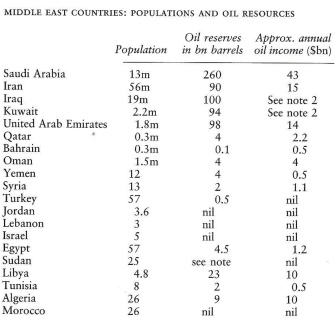 Map-15
Map-15
Oil in the Middle East came under close scrutiny and producer-countries were closely examined as to the policies of their governments and the attitudes of their people. Map-15 Oil. Britain’s concerns in 1956, had arisen again in the American spotlight, especially in relation to the influence of the Palestinian presence in the Gulf.
In the early 1980’s, and especially after Camp David Accords signed by Sadat and Begin in Sept 1978, the US Congress had confirmed its policy in the Middle East which rests on two pillars; one, the military superiority of Israel over all the Arab countries combined, and securing constant, sufficient and cheap oil supplies to the West. The two of course, are interrelated.
The well known professors of political science, John Mearsheimer and Stephen Walt wrote in their book "the Israel Lobby".
Washington also provides Israel with consistent diplomatic support. Since 1982, the US has vetoed 32 Security Council resolutions critical of Israel, more than the total number of vetoes cast by all the other Security Council members. It blocks the efforts of Arab states to put Israel’s nuclear arsenal on the IAEA’s agenda. The US comes to the rescue in wartime and takes Israel’s side when negotiating peace. The Israel Lobby
Israel’s security means to make it a regional superpower above the Arab countries and a military tool to use when needed. Securing oil supplies means that sufficient quantities of oil to meet Western needs as they change should be produced and the market price should not exceed acceptable limits. Hence, The Gulf countries, particularly Saudi Arabia, were very important strategic assets.
The US Congress, Committee on Foreign Affairs in its session of June 1979 described the activities of the US Armed forces as follow:
Saudi Arabia is a country of vital importance for the United States. For over two decades the Corps of Engineers has played an important and expanding role in helping the Saudi Arabian Government with military construction activities. The list of large projects—including new military cities in the desert, port facilities, military academies and training centers—is impressive. This list will total between $20 billion and $25 billion over the next 10 years. US Middle East
The twin policies of supporting Israel and securing the Arab oil were translated into the requirements that no Arab government should be allowed to hold power in the Gulf if it did not meet these demands. Hence, the Palestinians, who were considered as agitators against this policy, were not to be welcome in the Gulf.
In 1990, another disaster struck. Saddam Hussein invaded Kuwait. The US and its Western allies, and Arab forces from Egypt and Syria, rose quickly to repulse this attack, and Kuwait was liberated after six months’ occupation in February 1991. During the Kuwait occupation, the majority of Palestinians fled from Kuwait, but they were not able to return. There has been much controversy about this, a mixture of misinformation and prejudice. But basic facts remain clear.
Palestinians fled from Kuwait voluntarily because they did not want to stay under Saddam’s rule. Many Palestinians actually carried money and supplies for Kuwaiti families who remained at home because they could travel from and to Amman. It is a well-known fact the National Bank of Kuwait and the Gulf Bank could not have resumed business in London two weeks after the invasion without the dangerous and risky task of smuggling bank records by some Palestinians. When Kuwait was liberated, Palestinian engineers helped restore power generation; one of them was actually killed in the process.
In August 1990, before the invasion, Kuwait population was 2.2 million, of which Kuwaitis were 27%. Palestinians were 350,000 and Egyptians were 190,000. In the year 2011, the population in Kuwait rose to 3.3 million, of which Kuwaitis were about a third, that is 1.1 million and the same number were Asians. The Arabs percentage retreated to 20% percentage. Of that, the Egyptians’ number doubled to 450,000 and Palestinians’ number shrank to about 40,000 or 10% of their earlier percentage.
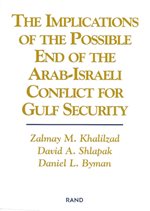 Map-16
Map-16
There is nothing clearer about Western policies regarding the Arab World in this period than this book by Rand Corporation. Map-16 Rand cover. Rand Corporation is a think-tank for the US government, especially the military. This study in this book was commissioned by the US Airforce and was published in 1997 after the liberation of Kuwait.
At that time, the Zionist neo-conservatives were clamouring to destroy Iraq by US forces on behalf of Israel. This came six years later. Thus the title of Rand study is quite revealing: It says that the question of Palestine and Israel is a key to the domination of the Gulf. It outlines the role Israel should play in the attack on the Arabian Peninsula and Iraq and Syria. It also shows not only the positive role Israel could play in achieving this objective, but also the negative role which the Palestinian question could play in undermining this objective.
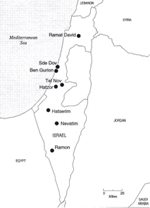 Map-17B
Map-17B
In the study, this map shows eight MOB’s in Israel, Map-17 MOB, meaning ‘main operating bases’ in Israel whish shall be used to attack Arab countries, explicitly or implicitly, within an American campaign. These bases are actually part of the 55 airports in Israel which had been used to attack Iraq.
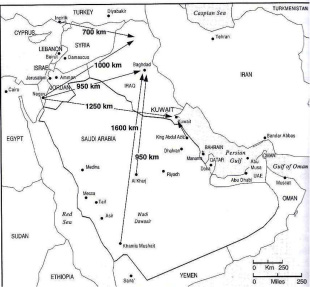 Map-17A
Map-17A
The Rand study shows also in this map Map Saudi bases how the combined forces with American bases in the Gulf and in Israel could be utilized to attack Arab countries. This took place in 2003 when Iraq was reduced to rubble. The pretext was to find and destroy WMD in Iraq.
This week the BBC aired a program called “Spies and Lies” documenting evidence that Iraq had never had WMD and the Western powers knew it. Tony Blair is under constant public attack in Britain for lying. But the damage was done and Israel is happy.
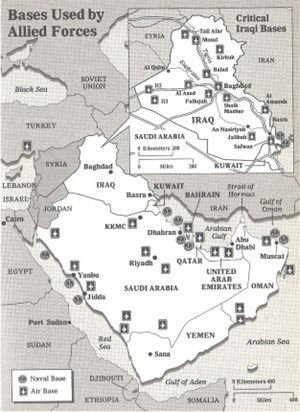 Map-18
Map-18
Without discussing this situation at length, it is clear that a possible war with Iran, instigated primarily by Israel, would involve the Gulf countries at least indirectly through the American bases in the area and through the hidden or open participation of Israel. Map-18 US Saudi bases. The shaded area on the left assumes Israel will not participate, but undoubtedly it will. It doesn’t need much convincing that Israel is a fundamental threat to the Arab world.
Netanyahu stoked the fire against Iran for the last few years for two valuable reasons. One: to distract the attention from the occupation and war crimes in Palestine. Two, to destroy Iran using US firepower, as it did in Iraq. If this happens and Iran retaliates, it would inevitably hit many assets in the Gulf as you have seen in the map. That would be another disaster. I hope it will never happen.
But there may be good news, I say may be. The Arab world was delighted with the advent of the ‘Arab Spring’, in which ordinary, helpless individual Arabs rose to topple their rulers at whose hands they suffered a great and lengthy oppression. It is not surprising that some of these rulers were frequently serving western interest at the price of western powers turning a blind eye to their violation of human rights and even helping them.
While the removal of these despotic rulers was successful, the creation of a new democratic order is a very difficult undertaking. Instead of recovering their independence as democratic states, the peoples’ revolt turned against each other. It is so tragic that the people who lived together for centuries suddenly discovered that their mortal enemy is their neighbor: Sunni or Shiite. Or that a minority suddenly found the need to demand cessation from its mother country, such as the Kurds in Iraq and Syria, and the Amazigi in Morocco and Algeria. We also find weaker governments unable to prevent splitting the country into two as in Sudan or incapable of confronting a serious threat to the Nile waters by Ethiopia.
Such bitter conclusions of popular uprising are very common; the history of Europe is a witness. The difference here is that there are enemies who are stoking the fire and waiting to jump on the occasion to dismember the Arab World.
In 1945, Ilyahu Epstein, renamed Eilat, held the position of the head of the Political Department of the Jewish Agency. In his book, “Zionism and the Arabs”, he described how Zionist emissaries were sent to Arab countries early in the 20th century to find pockets of weakness in the Arab World. They visited Bahrein and Kuwait in 1930’s and described the position of Sheikh Ahmed Al Jaber Al Sabah, his palace, his family and his strength. They had talks with the Kurds, the Druze and the Maronite. In all cases, they offered assistance and cooperation provided they split.
Ben Gurion plans to establish a Maronite state in Lebanon are fully documented. Not to miss the boat, Condoleezza Rice took the cue as part of US policy and gleefully predicted “the Birth pangs of the new Middle East” when Israel attacked Lebanon in 2006. The joy of birth turned into a nightmare when Hezbollah gave the Israelis a bloody nose.
Shimon Perez, the old fox, never tires of preaching for a New Middle East. He calls it a mosaic, separate and disparate pieces of marble of all colours, of weak and helpless little entities calling themselves states, in which Israel is the dominant and only power.
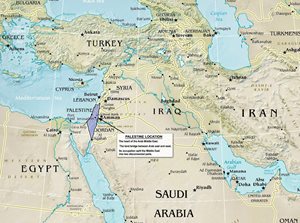 Map-19
Map-19
Map-19 Location. And these entities will then forget Palestine, will forget the largest, biggest and ethnic cleansing operation in modern history, will forget the only colonial project in the world today on Arab soil, will forget the centre of Apartheid in the world, which made Bishop Desmond Tutu says ‘Israel’s Apartheid is worse than South Africa’.
But that will never come to pass. The Arab World will regain its strength. Palestine will remain its main cause and its banner for freedom and independence. That is where Palestine is needed for the Gulf and for the whole Arab World: To focus on the real enemy, not to fight a brother or neighbour.
The Arab people’s first and foremost and permanent objective is not to fight each other on the basis of sect or ethnicity, but to remove the last vestiges of Western domination represented by Israel. Then they can use and develop their own immense recourses, utilize their vast geography and derive strength and wisdom from their long history.
This is the Arab World. It is not MENA, as they want us to call it, Middle East and North Africa. They could also describe it as south of Italy and north of Ethiopia. All these acrobatics are employed to avoid the use of the Arab World in order to allow the intrusion of Israel into it. It is and will always be the Arab World, blemishes, wounds and all.
No matter what news you heard yesterday and you will hear tomorrow, Palestine remains the Arabs’ principal cause. Its freedom is the only sign that the Arabs are truly free and independent.
With Palestine’s liberation, the legacy of the intruders in our homeland: Sykes, Picot, Balfour Ben Gurion and whatever will be buried for ever. And Jerusalem will be free again.
Thank you.